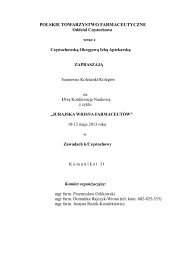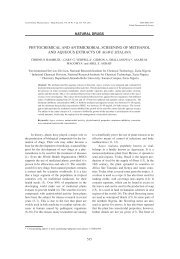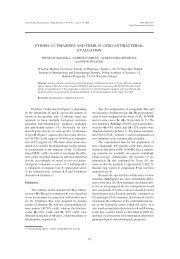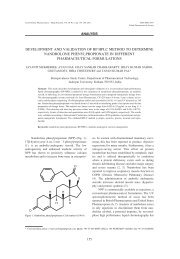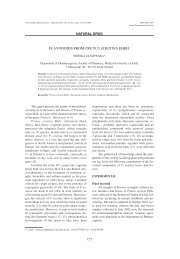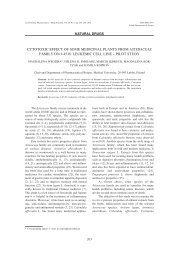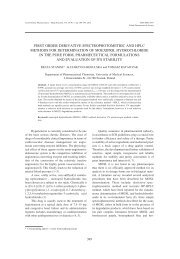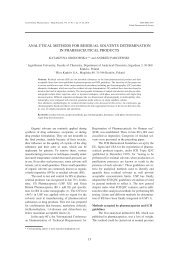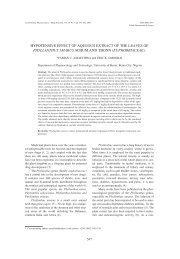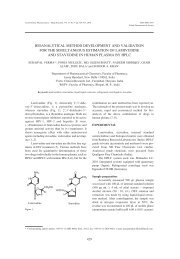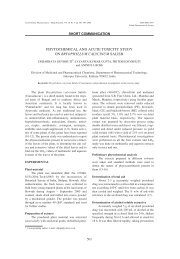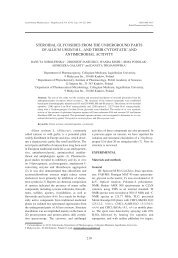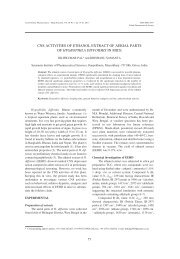identification and analysis of drugs in the solid state by 13c cpmas nmr
identification and analysis of drugs in the solid state by 13c cpmas nmr
identification and analysis of drugs in the solid state by 13c cpmas nmr
Create successful ePaper yourself
Turn your PDF publications into a flip-book with our unique Google optimized e-Paper software.
Acta Poloniae Pharmaceutica ñ Drug Research, Vol. 65 No. 3 pp. 295ñ301, 2008 ISSN 0001-6837<br />
Polish Pharmaceutical Society<br />
IDENTIFICATION AND ANALYSIS OF DRUGS IN THE SOLID STATE<br />
BY 13 C CPMAS NMR: SUXAMETHONIUM CHLORIDE<br />
AND HYDROCORTISONUM (CORHYDRON)<br />
KATARZYNA PARADOWSKA a , MICHA£ WOLNIAK a , ZBIGNIEW FIJA£EK b,c<br />
<strong>and</strong> IWONA WAWER a *<br />
a<br />
Department <strong>of</strong> Physical Chemistry, b Department <strong>of</strong> Drugs Analysis, The Medical University <strong>of</strong> Warsaw,<br />
Banacha 1, 02-091 Warsaw, c National Medic<strong>in</strong>es Institute, Che≥mska 30/34, 00-725 Warsaw, Pol<strong>and</strong><br />
Abstract: Cross-polarization (CP) magic angle sp<strong>in</strong>n<strong>in</strong>g (MAS) 13 C NMR spectroscopy has become a rout<strong>in</strong>e<br />
tool <strong>in</strong> pharmacy, employed to identify <strong>and</strong> characterize <strong>drugs</strong> <strong>in</strong> <strong>the</strong> <strong>solid</strong> phase. 13 C CPMAS NMR spectra<br />
were recorded for <strong>solid</strong> hydrocortisone 21-hemisucc<strong>in</strong>ate <strong>and</strong> suxamethonium chloride. White crystall<strong>in</strong>e substances,<br />
such as <strong>the</strong>se two <strong>drugs</strong>, can be easily dist<strong>in</strong>guished; <strong>and</strong> <strong>solid</strong>-<strong>state</strong> 13 NMRspectra <strong>of</strong> remarkably good<br />
quality are obta<strong>in</strong>ed <strong>in</strong> less than half an hour. 13 C CPMAS chemical shifts for <strong>solid</strong> suxamethonium chloride <strong>and</strong><br />
hydrocortisone sodium hemisucc<strong>in</strong>ate are given, as well as cross-polarization k<strong>in</strong>etic parameters for suxamethonium<br />
chloride.<br />
Keywords: suxamethonium chloride, hydrocortisone hemisucc<strong>in</strong>ate, <strong>solid</strong>-<strong>state</strong> NMR, 13 C CPMAS NMR<br />
In November 2006 Polish newspapers reported<br />
news about an outrageous error at Jelfa, <strong>the</strong> pharmaceutical<br />
company based <strong>in</strong> Jelenia GÛra. The company<br />
manufactures corhydron, a powerful anti-allergenic<br />
drug. Because <strong>of</strong> <strong>the</strong> GMP mistake <strong>by</strong> <strong>the</strong><br />
manufacturer, some <strong>of</strong> <strong>the</strong> vials conta<strong>in</strong>ed a different<br />
active <strong>in</strong>gredient. Analysts from <strong>the</strong> National<br />
Medic<strong>in</strong>es Institute found that <strong>in</strong>stead <strong>of</strong> corhydron,<br />
<strong>the</strong> vials conta<strong>in</strong>ed chlorsuccill<strong>in</strong>, a muscle relaxant<br />
used dur<strong>in</strong>g surgery. The suspended batches <strong>of</strong><br />
Corhydron 250 mg were withdrawn from <strong>the</strong> market<br />
<strong>by</strong> <strong>the</strong> Ma<strong>in</strong> Pharmaceutical Inspectorate (GIF).<br />
This manufacturerís mistake was mentioned <strong>in</strong> <strong>the</strong><br />
Lancet (1).<br />
Besides <strong>the</strong> matters connected with logistic <strong>and</strong><br />
quality system <strong>in</strong> <strong>the</strong> pharmaceutical plant, this accident<br />
raises <strong>the</strong> problem <strong>of</strong> analytical methods suitable<br />
for fast <strong>identification</strong> <strong>of</strong> unknown <strong>solid</strong> samples.<br />
Techniques typically employed to identify <strong>and</strong><br />
characterize <strong>drugs</strong> <strong>in</strong> <strong>the</strong> <strong>solid</strong> phase are: melt<strong>in</strong>g<br />
po<strong>in</strong>t, differential scann<strong>in</strong>g calorimetry, IR spectroscopy<br />
<strong>and</strong> X-ray diffraction. Crystallography produces<br />
detailed maps <strong>of</strong> atomic positions <strong>in</strong> <strong>the</strong> unit<br />
cell <strong>and</strong> is an excellent tool <strong>of</strong> <strong>solid</strong>-<strong>state</strong> characterization.<br />
However, <strong>the</strong> problem <strong>of</strong> obta<strong>in</strong><strong>in</strong>g s<strong>in</strong>gle<br />
crystal is difficult to overcome <strong>and</strong> o<strong>the</strong>r methods<br />
are <strong>of</strong>ten desirable. Never<strong>the</strong>less, <strong>the</strong> X-ray powder<br />
diffraction, especially when us<strong>in</strong>g new, fast diffraction<br />
techniques, <strong>in</strong>clud<strong>in</strong>g multilayer mirrors <strong>and</strong><br />
position-sensitive counters, is a method suitable for<br />
pharmaceutical market screen<strong>in</strong>g control.<br />
Now that high-resolution 13 C NMR spectra <strong>of</strong><br />
organic <strong>solid</strong>s can be obta<strong>in</strong>ed relatively easily, it<br />
has become important to popularize <strong>solid</strong>-<strong>state</strong><br />
NMR method as a rout<strong>in</strong>e tool <strong>in</strong> pharmacy. Magic<br />
angle sp<strong>in</strong>n<strong>in</strong>g (MAS) NMR spectroscopy makes<br />
significant contribution to <strong>the</strong> studies on <strong>drugs</strong> <strong>and</strong><br />
is applied to confirm <strong>the</strong>ir identity, purity <strong>and</strong> stability<br />
(2). It enables nondestructive <strong>and</strong> fast <strong>identification</strong><br />
<strong>of</strong> an active compound s<strong>in</strong>ce <strong>the</strong> 13 C measurements<br />
are performed on pure powdered <strong>solid</strong> (without<br />
dilution with a solvent).<br />
Suxamethonium chloride (succ<strong>in</strong>ylchol<strong>in</strong>e or<br />
sux; Scheme 1a) is a drug widely used <strong>in</strong> emergency<br />
medic<strong>in</strong>e <strong>and</strong> anes<strong>the</strong>sia to <strong>in</strong>duce muscle relaxation.<br />
The compound consists <strong>of</strong> two acetylchol<strong>in</strong>e<br />
molecules l<strong>in</strong>ked <strong>by</strong> <strong>the</strong>ir acetyl groups.<br />
Suxamethonium chloride is a white crystall<strong>in</strong>e substance,<br />
odorless <strong>and</strong> highly soluble <strong>in</strong> water.<br />
Hydrocortisonum (Cortisol, Corhydron;<br />
Scheme 1b) is used to treat asthma <strong>and</strong> certa<strong>in</strong> allergies.<br />
It is a representative <strong>of</strong> corticosteroids, <strong>the</strong><br />
* Correspond<strong>in</strong>g author: e-mail: wawer@farm.amwaw.edu.pl<br />
295
296 KATARZYNA PARADOWSKA et al.<br />
most frequently used class <strong>of</strong> anti-<strong>in</strong>flammatory<br />
<strong>drugs</strong>, important <strong>in</strong> <strong>the</strong> <strong>the</strong>rapy <strong>of</strong> neoplastic,<br />
immunological <strong>and</strong> allergic diseases.<br />
Hydrocortisone sodium hemisucc<strong>in</strong>ate is a white<br />
crystall<strong>in</strong>e powder, soluble <strong>in</strong> water.<br />
Therefore, <strong>the</strong>se two <strong>drugs</strong> cannot be easily<br />
dist<strong>in</strong>guished <strong>in</strong> <strong>the</strong>ir crystall<strong>in</strong>e form. In order to<br />
determ<strong>in</strong>e chemical structure <strong>and</strong> <strong>in</strong>termolecular<br />
<strong>in</strong>teractions <strong>in</strong> <strong>the</strong> <strong>solid</strong> <strong>state</strong>, <strong>the</strong> MAS NMR spectroscopy<br />
methods have to be used.<br />
EXPERIMENTAL<br />
Suxamethonium chloride, systematic (IUPAC)<br />
name: 2,2í-[(1,4-dioxobutane-1,4-diyl)bis(oxy)]bis-<br />
-(N,N,N-trimethylethanam<strong>in</strong>ium) <strong>and</strong> Hydrocortisone<br />
sodium 21-hemisucc<strong>in</strong>ate, a water-soluble<br />
ester <strong>of</strong> hydrocortisone (sodium 11,17-dihydroxy-<br />
3,20-dioxopregn-4-en-21-yl succ<strong>in</strong>ate) were obta<strong>in</strong>ed<br />
from Pharmaceutical Company Jelfa SA.<br />
Cross polarization (CP) magic angle sp<strong>in</strong>n<strong>in</strong>g<br />
(MAS) <strong>solid</strong>-<strong>state</strong> 13 C NMR spectra were recorded at<br />
100.13 MHz on a Bruker DSX-400 <strong>in</strong>strument.<br />
Powder samples were spun at 8-13 kHz <strong>in</strong> a 4 mm<br />
ZrO 2 rotor, contact time <strong>of</strong> 4-5 ms, repetition time <strong>of</strong><br />
6 s <strong>and</strong> spectral width <strong>of</strong> 40 kHz were used for<br />
accumulation <strong>of</strong> 400 ñ 800 scans. Dipolar dephas<strong>in</strong>g<br />
pulse sequence (with 50 ms delay time <strong>in</strong>serted<br />
before acquisition) was used to observe selectively<br />
<strong>the</strong> nonprotonated carbon atoms. Chemical shifts<br />
were calibrated <strong>in</strong>directly through <strong>the</strong> glyc<strong>in</strong>e CO<br />
signal recorded at 176.0 ppm relative to TMS.<br />
RESULTS AND DISCUSSION<br />
Suxamethonium chloride<br />
Succ<strong>in</strong>ylchol<strong>in</strong>e was first applied to cl<strong>in</strong>ics <strong>in</strong><br />
Europe <strong>in</strong> 1951, <strong>and</strong> still has cl<strong>in</strong>ical utility today,<br />
although it exhibits numerous complications. Its role<br />
<strong>in</strong> cl<strong>in</strong>ical anes<strong>the</strong>sia <strong>and</strong> <strong>the</strong> mechanism <strong>of</strong> action as<br />
neuromuscular block<strong>in</strong>g were discussed <strong>in</strong> 2003 (3).<br />
Structurally, succ<strong>in</strong>ylchol<strong>in</strong>e consists <strong>of</strong> two molecules<br />
<strong>of</strong> acetylchol<strong>in</strong>e jo<strong>in</strong>ed end on end at <strong>the</strong> acetyl<br />
side. The crystal structure <strong>of</strong> succ<strong>in</strong>ylchol<strong>in</strong>e salts,<br />
<strong>in</strong>cluc<strong>in</strong>g iodide (4, 5) was established forty years<br />
ago. Molecular structures showed extended cha<strong>in</strong>s<br />
l<strong>in</strong>ked <strong>by</strong> <strong>in</strong>termolecular NHÖO=C hydrogen<br />
bonds.<br />
Accord<strong>in</strong>g to our best knowledge, <strong>the</strong> drug was<br />
not studied <strong>by</strong> means <strong>of</strong> <strong>solid</strong>-<strong>state</strong> NMR. Therefore,<br />
13<br />
C CPMAS NMR spectra were recorded, <strong>and</strong> <strong>the</strong><br />
spectra recorded at various rotational speeds (4-12<br />
KHz) are illustrated <strong>in</strong> Figure 1. The signal <strong>of</strong> C=O<br />
group is flanked <strong>by</strong> rotational side-b<strong>and</strong>s on both<br />
sides; it raises technical problem: how fast should<br />
<strong>the</strong> sample rotate to obta<strong>in</strong> side-b<strong>and</strong>s free spectrum?<br />
Large chemical shift anisotropy is typical for<br />
carbonyl carbon atoms, <strong>and</strong> samples with <strong>the</strong>m need<br />
to be spun at speeds <strong>in</strong> excess <strong>of</strong> 12 kHz. The <strong>in</strong>tensity<br />
<strong>of</strong> central l<strong>in</strong>e (isotropic) <strong>in</strong>creases (reach<strong>in</strong>g<br />
95%) at 12 kHz <strong>and</strong> <strong>in</strong>tensities <strong>of</strong> side-b<strong>and</strong>s<br />
decrease with <strong>in</strong>creas<strong>in</strong>g sp<strong>in</strong>n<strong>in</strong>g speed, as illustrated<br />
<strong>in</strong> Figure 2.<br />
The spectrum <strong>of</strong> suxamethonium chloride<br />
exhibited only five resonances; it <strong>in</strong>dicates that two<br />
acetylchol<strong>in</strong>e units ei<strong>the</strong>r have <strong>the</strong> same geometry<br />
<strong>and</strong> <strong>in</strong>termolecular contacts or exhibit dynamics i.e.<br />
undergo <strong>in</strong>ternal rotation. In solution, fast rotation<br />
around s<strong>in</strong>gle bonds takes place, whereas <strong>in</strong> <strong>the</strong><br />
<strong>solid</strong> <strong>state</strong> frozen conformation usually revealed different<br />
chemical sites. Additionally, <strong>in</strong>termolecular<br />
<strong>in</strong>teractions directed to specific sites may produce<br />
different chemical shifts for functional groups, such<br />
as C=O. The spectra were assigned on <strong>the</strong> basis <strong>of</strong><br />
liquid-<strong>state</strong> chemical shifts <strong>and</strong> 13 C chemical shifts<br />
are collected <strong>in</strong> Table 1. The <strong>solid</strong> <strong>state</strong> peaks have<br />
chemical shifts almost <strong>the</strong> same as <strong>the</strong>ir liquid <strong>state</strong><br />
counterparts. The differences ∆ = δ solution ñ δ CPMAS for<br />
methylene carbons are less that 1 ppm; deshield<strong>in</strong>g<br />
<strong>of</strong> ca. 2 ppm for <strong>solid</strong> was observed only for C=O.<br />
It seemed <strong>in</strong>terest<strong>in</strong>g to study molecular<br />
dynamics <strong>and</strong> cross-polarization k<strong>in</strong>etics <strong>in</strong> detail.<br />
Cross-polarization sequence provides evident<br />
advantages, such as signal enhancement <strong>and</strong> reduction<br />
<strong>of</strong> <strong>the</strong> measurement time, but <strong>the</strong> <strong>in</strong>tensity <strong>of</strong><br />
signals depends on CP parameters. The spectra <strong>of</strong><br />
suxamethonium chloride recorded with various<br />
Scheme 1. Molecular structures <strong>of</strong> succ<strong>in</strong>ylchol<strong>in</strong>e (a) <strong>and</strong> hydrocortisone<br />
hemisucc<strong>in</strong>ate (b) with carbon number<strong>in</strong>g.
Identification <strong>and</strong> <strong>analysis</strong> <strong>of</strong> <strong>drugs</strong> <strong>in</strong> <strong>the</strong> <strong>solid</strong> <strong>state</strong> <strong>by</strong>... 297<br />
Figure 1. 13 C <strong>solid</strong> <strong>state</strong> spectra <strong>of</strong> suxamethonium chloride recorded with different magic angle sp<strong>in</strong>n<strong>in</strong>g speeds.<br />
contact times t cp are illustrated <strong>in</strong> Figure 3.<br />
Protonated carbon atoms have fast polarization rate<br />
<strong>and</strong> <strong>the</strong> signals <strong>of</strong> methylene groups are <strong>in</strong>tense for<br />
short t cp . As expected, quaternary carbon atoms<br />
need longer time, especially C=O reach<strong>in</strong>g <strong>the</strong> maximum<br />
with t cp = 3.5 ms. This effect should be taken<br />
<strong>in</strong>to account <strong>in</strong> quantitative measurements, <strong>and</strong> may<br />
be helpful <strong>by</strong> assignment <strong>of</strong> <strong>the</strong> resonances, e.g. dist<strong>in</strong>guish<strong>in</strong>g<br />
quaternary carbon atoms from CH or<br />
CH 2 ones.<br />
In order to obta<strong>in</strong> <strong>the</strong> values <strong>of</strong> cross-polarization<br />
time constant T CP <strong>and</strong> proton sp<strong>in</strong>-lattice relaxation<br />
time <strong>in</strong> <strong>the</strong> rotation frame T 1ρH for <strong>the</strong> I-S<br />
model, an unrestricted fit <strong>of</strong> <strong>the</strong> experimental data to<br />
<strong>the</strong> equation (1) was performed:<br />
(1) I(t) = A(1-T CP /T 1ρH ) -1 [exp(- t/ T 1ρH ) ñ exp(- t/<br />
T CP )], where A is <strong>the</strong> <strong>in</strong>tensity amplitude.<br />
Cross-polarization <strong>in</strong> <strong>the</strong> C-H bonds (CH 2 <strong>and</strong><br />
CH 3 groups) proceeds accord<strong>in</strong>g to <strong>the</strong> I-I*-S model.<br />
Figure 2. Intensity <strong>of</strong> isotropic l<strong>in</strong>e <strong>and</strong> two sets <strong>of</strong> sp<strong>in</strong>n<strong>in</strong>g side<br />
b<strong>and</strong>s <strong>in</strong> <strong>the</strong> spectra recorded at various sp<strong>in</strong>n<strong>in</strong>g speeds.
298 KATARZYNA PARADOWSKA et al.<br />
The k<strong>in</strong>etics with<strong>in</strong> this model is described <strong>by</strong> equation<br />
(2):<br />
(2) I(t) = A exp(-t/T 1ρI )[1- λ exp(-t/T df ) ñ (1-λ) exp<br />
(-1.5t/T df ) exp(-0.5t 2 /T 22<br />
)], where T 2 is cross-polarization<br />
time constant for this model <strong>and</strong> T df is <strong>the</strong><br />
proton sp<strong>in</strong> diffusion.<br />
The cross-polarization k<strong>in</strong>etic parameters<br />
obta<strong>in</strong>ed us<strong>in</strong>g I-S <strong>and</strong> I-I*-S models are collected <strong>in</strong><br />
Table 1. Signal <strong>in</strong>tensity for C=O carbon atom versus<br />
contact time <strong>and</strong> fitt<strong>in</strong>g to <strong>the</strong> I-S model (T CP = 1<br />
ms <strong>and</strong> T 1ρ = 4.6 ms) is illustrated <strong>in</strong> Figure 4a.<br />
Cross-polarization k<strong>in</strong>etics for methylene carbon<br />
atom (δ 59 ppm) <strong>and</strong> fitt<strong>in</strong>g to I-I*-S model gives T 2<br />
= 2.5 ms <strong>and</strong> T df = 20 ms (Figure 4b). Fast decay <strong>of</strong><br />
signals <strong>in</strong>tensities at longer contact times suggests<br />
<strong>the</strong> absence <strong>of</strong> <strong>in</strong>tramolecular dynamics. Flexible<br />
Figure 3. The 13 C CP MAS spectra <strong>of</strong> suxamethonium chloride recorded with various contact times.
Identification <strong>and</strong> <strong>analysis</strong> <strong>of</strong> <strong>drugs</strong> <strong>in</strong> <strong>the</strong> <strong>solid</strong> <strong>state</strong> <strong>by</strong>... 299<br />
Table 1. 13 C chemical shifts (δ, ppm) for carbons <strong>of</strong> suxamethonium chloride <strong>in</strong> solution (DMSO-d 6 ) <strong>and</strong> <strong>solid</strong> <strong>state</strong>, <strong>and</strong> cross polarization<br />
parameters (ms) as obta<strong>in</strong>ed us<strong>in</strong>g two CP models.<br />
C Carbon type Model I-S Model I*I-S<br />
δ solution δ CPMAS T CP T 1ρ T 2 T df<br />
1,8 63,47 63,5 CH 2 ñ 4.1 ± 0.2 2.6 ± 0.1 22.7 ± 1.6<br />
2,7 58,06 59,3 CH 2 ñ 3.9 ± 0.1 2.4 ± 0.2 19.4 ± 1.2<br />
3,6 171,43 173,5 C=O 1.09 ± 0.07 4.6 ± 0.2 ñ ñ<br />
4,5 28,54 29,4 CH 2<br />
CH 3 52,79 53,8 NCH 3 0.22 ± 0.01 4.1 ± 0.2 ñ ñ<br />
Table 2. 13 C NMR chemical shifts (δ, ppm) <strong>of</strong> cortisone hemisucc<strong>in</strong>ate<br />
<strong>in</strong> solution (acetone-d 6 ) <strong>and</strong> <strong>solid</strong> <strong>state</strong>; <strong>the</strong> differences<br />
∆= δ solution ñ δ CPMAS >1 ppm.<br />
C δ solution δ CPMAS ∆<br />
1 32.26 32.8<br />
2 33.46 32.8<br />
3 204.69 201.7 3.0<br />
4 121.39 121.9<br />
5 175.34 175.0<br />
6 32.43 32.8<br />
7 31.48 32.8 -1.3<br />
8 30.52 32.8 -2.3<br />
9 56.09 56.4<br />
10 39.05 39.5<br />
11 69.06 68.0<br />
12 39.57 39.5<br />
13 47.62 47.4<br />
14 52.48 52.3<br />
15 23.56 23.5<br />
16 32.99 32.8<br />
17 90.13 89.5<br />
18 16.78 17.2<br />
19 20.78 20.6<br />
20 209.28 209.0<br />
21 68.12 68.0<br />
succ<strong>in</strong>ate anion<br />
a 176,08 179.6 -3.5<br />
b 28,96 30<br />
c 28,67 30<br />
d 170,94 172.2 -1.2<br />
a<br />
b<br />
Figure 4. Cross-polarization k<strong>in</strong>etics for: (a) C=O carbon (I-S<br />
model) <strong>and</strong> (b) CH 2 (I-I * S model) <strong>of</strong> suxamethonium chloride.<br />
Signal <strong>in</strong>tensity <strong>in</strong> arbitrary units (a.u.), contact time <strong>in</strong> ms.<br />
molecular fragments are usually characterized <strong>by</strong><br />
very long relaxation times T 1ρH . The CP curves for<br />
carbon atoms <strong>of</strong> beta-carotene cha<strong>in</strong> ended with<br />
plateau (6).<br />
Hydrocortisone hemisucc<strong>in</strong>ate<br />
In <strong>the</strong> medical literature, reports on an anaphylactoid<br />
reaction to hydrocortisone sodium succ<strong>in</strong>ate<br />
given <strong>in</strong>travenously are rare. However, <strong>the</strong> corticosteroid-<strong>in</strong>duced<br />
adverse events observed <strong>in</strong> adults<br />
represent a broad cl<strong>in</strong>ical spectrum, as lastly<br />
reviewed (7, 8). Hydrocortisone sodium succ<strong>in</strong>ate, a<br />
water-soluble ester which is used for <strong>in</strong>travenous<br />
adm<strong>in</strong>istration, is hydrolyzed to <strong>the</strong> hydrocortisone,<br />
<strong>the</strong> presumed active compound. The hydrolysis <strong>of</strong><br />
hydrocortisone 21-hemisucc<strong>in</strong>ate has been studied<br />
(9) <strong>in</strong> alkal<strong>in</strong>e aqueous solution. Several methods<br />
have been described for determ<strong>in</strong><strong>in</strong>g hydrocortisone<br />
<strong>and</strong> hydrocortisone succ<strong>in</strong>ate <strong>in</strong> plasma; however,<br />
<strong>the</strong> widely used liquid chromatography (HPLC) <strong>and</strong>
300 KATARZYNA PARADOWSKA et al.<br />
Figure 5. 13 C CPMAS NMR spectra <strong>of</strong> cortisone hemisucc<strong>in</strong>ate: a) st<strong>and</strong>ard <strong>and</strong> b) with depolar dephas<strong>in</strong>g.<br />
isotope dilution-mass spectrometry are time-consum<strong>in</strong>g<br />
<strong>and</strong> expensive (10). For <strong>the</strong> future NMR<br />
study <strong>of</strong> <strong>the</strong> metabolism <strong>in</strong> humans isotopically<br />
labeled compounds are necessary. The syn<strong>the</strong>sis <strong>of</strong><br />
multi-labeled cortisol <strong>and</strong> cortisone with 13 C <strong>and</strong> 2 H<br />
was described (11), <strong>and</strong> <strong>the</strong>ir 13 C <strong>and</strong> 1 H NMR spectra<br />
were fully assigned.<br />
Cortisone <strong>in</strong> <strong>the</strong> form <strong>of</strong> <strong>the</strong> acetate ester exists<br />
<strong>in</strong> <strong>solid</strong> phase <strong>in</strong> several polymorphic forms, also as<br />
solvated crystals (pseudopolymorphs). Six crystall<strong>in</strong>e<br />
forms were dist<strong>in</strong>ctly found <strong>by</strong> <strong>the</strong> <strong>analysis</strong> <strong>of</strong><br />
<strong>solid</strong> <strong>state</strong> 13 C NMR spectra <strong>of</strong> n<strong>in</strong>e various samples<br />
(12). Crystal structures are known for three forms<br />
<strong>and</strong>, <strong>the</strong>refore some correlation between NMR <strong>and</strong><br />
XRD results could be made. Chemical shift differences<br />
between <strong>solid</strong> forms appear <strong>in</strong> <strong>the</strong> side cha<strong>in</strong><br />
<strong>and</strong> <strong>the</strong> conformations <strong>of</strong> r<strong>in</strong>g A. Chemical shift <strong>of</strong><br />
C3=O is larger for <strong>solid</strong> sample than for solution<br />
spectra, <strong>the</strong> effect is related with hydrogen bond<strong>in</strong>g.<br />
Separate CH <strong>and</strong> CH 2 resonances <strong>in</strong> 13 C MAS spectra<br />
can be obta<strong>in</strong>ed <strong>by</strong> polarization <strong>in</strong>version follow<strong>in</strong>g<br />
cross polarization (a CPPI procedure). This procedure<br />
has been applied to polymorphism situations,<br />
as illustrated <strong>by</strong> Harris (13) for form I <strong>of</strong> cortisone<br />
acetate. However, <strong>the</strong>re is no <strong>solid</strong>-<strong>state</strong> NMR data<br />
on hydrocortisone hemisucc<strong>in</strong>ate.<br />
13<br />
C CPMAS NMR spectra were recorded for<br />
<strong>solid</strong> hydrocortisone 21-hemisucc<strong>in</strong>ate, <strong>and</strong> st<strong>and</strong>ard<br />
spectrum is shown <strong>in</strong> Figure 5a. Chemical<br />
shifts are collected <strong>in</strong> Table 2. The spectra were<br />
assigned on <strong>the</strong> basis <strong>of</strong> liquid-<strong>state</strong> chemical shifts<br />
<strong>and</strong> dipolar dephas<strong>in</strong>g (DD) experiment The <strong>solid</strong><br />
<strong>state</strong> peaks have chemical shifts almost <strong>the</strong> same as<br />
<strong>the</strong>ir liquid <strong>state</strong> counterparts. The differences <strong>of</strong><br />
3.0-3.5 ppm were observed for carbonyl carbons.<br />
Deshield<strong>in</strong>g <strong>of</strong> 3.5 ppm occurs for carbonyl carbon<br />
atom (a) <strong>of</strong> ester l<strong>in</strong>kage. These results <strong>in</strong>dicate that<br />
steroid structure is relatively rigid <strong>in</strong> solution, without<br />
much conformational freedom <strong>and</strong> result<strong>in</strong>g<br />
average <strong>of</strong> chemical shifts. The signals <strong>of</strong> methylene<br />
carbon atoms: 1, 2, 6, 7, 8 <strong>and</strong> 15, as well as<br />
those <strong>of</strong> succ<strong>in</strong>ate (b, c) give rise to a broad peak at<br />
30-33 ppm. The resonances <strong>of</strong> quaternary carbon<br />
atoms C10 <strong>and</strong> C13 can be easily dist<strong>in</strong>guished <strong>in</strong><br />
<strong>the</strong> spectrum recorded with DD pulse sequence<br />
(Figure 5b). All resonances appear to be broader<br />
<strong>the</strong>n usually observed for crystall<strong>in</strong>e steroid-type<br />
compounds, <strong>in</strong>dicat<strong>in</strong>g that <strong>the</strong> studied sample is<br />
amorphous.<br />
CONCLUSIONS<br />
13<br />
C CPMAS NMR allows for fast <strong>identification</strong><br />
<strong>of</strong> <strong>solid</strong> organic material, without any preparation<br />
procedures. The advantage <strong>of</strong> <strong>solid</strong>-<strong>state</strong> technique<br />
is also its non-destructive character; <strong>the</strong> sample<br />
removed from rotor can be fur<strong>the</strong>r used for <strong>analysis</strong><br />
<strong>by</strong> solution NMR or chromatography. It is evident at<br />
first sight that <strong>the</strong> 13 C MAS spectra <strong>of</strong> hydrocortisone<br />
<strong>and</strong> succ<strong>in</strong>ylchol<strong>in</strong>e are quite different,<br />
although both compounds have carbonyl <strong>and</strong> methylene<br />
groups.
Identification <strong>and</strong> <strong>analysis</strong> <strong>of</strong> <strong>drugs</strong> <strong>in</strong> <strong>the</strong> <strong>solid</strong> <strong>state</strong> <strong>by</strong>... 301<br />
REFERENCES<br />
1. Cienski J.: Lancet 368, 2116 (2006)<br />
2. Holzgrabe U., Wawer I., Diehl B.: NMR spectroscopy<br />
<strong>in</strong> drug development <strong>and</strong> <strong>analysis</strong>, p.<br />
231,Wiley-VCH, We<strong>in</strong>heim, New York,<br />
Chichester, Brisbane, S<strong>in</strong>gapore, Toronto 1999.<br />
3. Lee C.: Pharmacol. Ther. 98, 143 (2003).<br />
4. Jensen B.: Acta Chem. Sc<strong>and</strong>. 22, 2035 (1968).<br />
5. Jensen B.: Acta Chem. Sc<strong>and</strong>. 24, 2517 (1970).<br />
6. Ko≥odziejski W., Kasprzycka-Gutman T.: Solid<br />
State Nucl. Magn. Reson. 11, 177 (1998).<br />
7. Fardet L., Kassar A., Cabane J., Flahault A.:<br />
Drug Saf. 30, 861(2007)<br />
8. Fardet L. , Flahault A., Kettaneh A., Tiev K.P.,<br />
GÈnÈreau T., TolÈdano C., LebbÈ C.,<br />
Cabane J.: Br. J. Dermatol. 157, 142 (2007).<br />
9. Garrett E.R..: J. Pharm. Sci. 51, 445 (1962).<br />
10. Iwasaki E.: Cl<strong>in</strong>. Chem. 33, 1412 (1987).<br />
11. Furuta T., Eguchi N., Yokokawa A., Shibasaki<br />
H., Kasuya Y.: Steroids 65, 180 (2000).<br />
12. Harris R.K., Kenwright A.M., Say B.J., Yeung<br />
R.R., Fletton R.A., Lancaster R.W., Hardgrove<br />
G.L.: Spectrochim. Acta 46A, 927 (1990).<br />
13. Harris R.K.: Analyst 131, 351 (2006).<br />
Received: 24. 01. 2008



